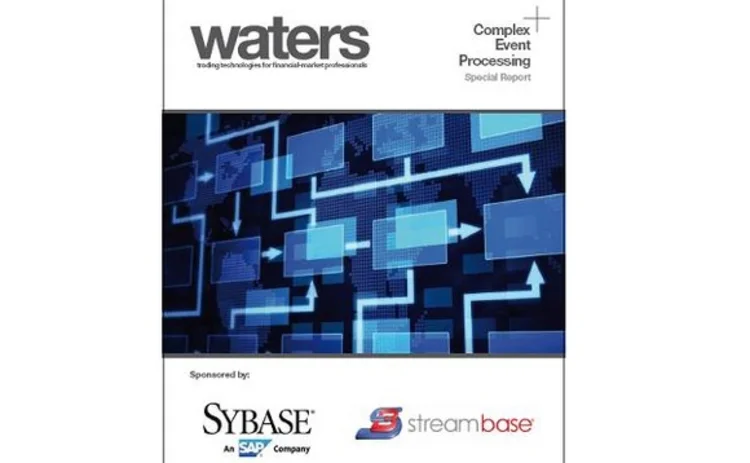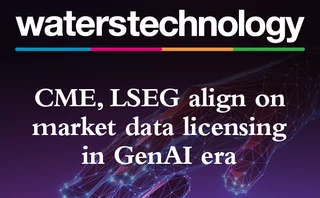Complex Event Processing special report

Click here to download the PDF
Talk Is Cheap
Like it or not, high-frequency trading (HFT) is here to stay. Regardless of what the regulators might be saying about the practice in order to placate the various constituents they represent, HFT plays such a crucial role in mature financial markets-and, increasingly, in emerging markets too-that it's inconceivable that they are ever going to get to the point where they seriously contemplate clipping HFT firms' wings. Anyone who has been part of the financial services industry for any appreciable amount of time will know that talk is cheap. Sure, we might, see "speed limits" imposed in the interest of promoting a fair and competitive marketplace, but who gets to say how fast is too fast and who draws that arbitrary line in the sand is anyone's guess. But that's a discussion for another time.
Complex event processing (CEP), the practice of low-latency filtering, correlating, aggregating, and computing, based on a wide range of historical and real-time streaming data, plays a significant role in firms' abilities to make judicious trading decisions. Buy-side and sell-side firms, especially those with high-frequency businesses, are under increasing competitive pressure to execute large trade volumes with the minimum amount of latency, a scenario exacerbated by an ever-expanding financial services industry generating massive data volumes from a vast array of disparate sources.
Not only is it unfeasible to expect humans to monitor all of this data, but it's also massively time-consuming to the point of rendering any high-frequency business obsolete. But this is where CEP comes into its own, which, as we see in this special report, has permeated the lucrative foreign-exchange (FX) market from its natural starting point of equities. But the latest generation of CEP products are about more than simply processing and interpreting large quantities of data: Many such offerings now include liquidity aggregation, algorithmic trading, risk management and surveillance tools, providing users with a one-stop shop to not only access the "cleanest" liquidity, but also to work orders and manage their risk in increasingly sophisticated fashions.
Click here to download the PDF
Only users who have a paid subscription or are part of a corporate subscription are able to print or copy content.
To access these options, along with all other subscription benefits, please contact info@waterstechnology.com or view our subscription options here: https://subscriptions.waterstechnology.com/subscribe
You are currently unable to print this content. Please contact info@waterstechnology.com to find out more.
You are currently unable to copy this content. Please contact info@waterstechnology.com to find out more.
Copyright Infopro Digital Limited. All rights reserved.
As outlined in our terms and conditions, https://www.infopro-digital.com/terms-and-conditions/subscriptions/ (point 2.4), printing is limited to a single copy.
If you would like to purchase additional rights please email info@waterstechnology.com
Copyright Infopro Digital Limited. All rights reserved.
You may share this content using our article tools. As outlined in our terms and conditions, https://www.infopro-digital.com/terms-and-conditions/subscriptions/ (clause 2.4), an Authorised User may only make one copy of the materials for their own personal use. You must also comply with the restrictions in clause 2.5.
If you would like to purchase additional rights please email info@waterstechnology.com
More on Trading Tech
Will overnight trading in equity markets expand next year? It’s complicated.
The potential for expanded overnight trading in US equity markets sparked debate this year, whether people liked it or not.
WatersTechnology latest edition
Check out our latest edition, plus more than 13 years of our best content.
The total portfolio approach gains momentum: Building the right tech foundation for success
The rationale for the TPA, and the crucial role technology plays in enabling such an approach
Google, CME say they’ve proved cloud can support HFT—now what?
After demonstrating in September that ultra-low-latency trading can be facilitated in the cloud, the exchange and tech giant are hoping to see barriers to entry come down.
Institutional priorities in multi-asset investing
Private markets, broader exposures and the race for integration
BlackRock and AccessFintech partner, LSEG collabs with OpenAI, Apex launches Pisces service, and more
The Waters Cooler: CJC launches MDC service, Centreon secures Sixth Street investment, UK bond CT update, and more in this week’s news roundup.
TCB Data-Broadhead pairing highlights challenges of market data management
Waters Wrap: The vendors are hoping that blending TCB’s reporting infrastructure with Broadhead’s DLT-backed digital contract and auditing engine will be the cure for data rights management.
Robeco tests credit tool built in Bloomberg’s Python platform
This follows the asset manager’s participation in Bloomberg’s Code Crunch hackathon in Singapore, alongside other firms including LGT Investment Bank and university students.








